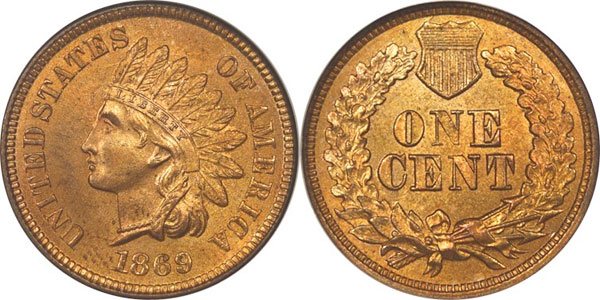Guide to U.S. Indian Head Cents
The Indian Head Cent features an enduring depiction of Liberty in a Native American headdress. The popular series had been introduced after only two years of production for the prior design, which had proven difficult to mint. The initial production of the newly designed cents also experienced problems, resulting in some early changes. The series would go on to enjoy a lengthy run from 1859 to 1909, when it would be replaced with the Lincoln Cent.

Following more than 60 years of production for the copper large cents, the format was finally abandoned in favor of a small-sized cent struck in an alloy of copper and nickel. The initial small cents featured a flying eagle, but striking the design on the hard alloy was problematic and most pieces showed weakness in different areas. A new design was sought to solve the problem. After many different patterns had been produced, the design now identified as Judd-208 was selected.
The obverse features Liberty wearing an Indian headdress, which incorrectly led the general public to identify the image as an “Indian Head.” The word LIBERTY appears at the base of the headdress, with inscriptions of UNITED STATES OF AMERICA and the date surrounding. The reverse design features a laurel wreath tied at the base with a bold inscription of ONE CENT positioned at the center. The coin’s designer was James Barton Longacre, and some sources say the rendering of Liberty was based on his daughter Sarah. Although this has not been confirmed, the portrait shows some similarities to drawings of her.
Regular production of the Indian Head Cent started in 1859, which became a one-year subtype. The following year the design was modified to reduce striking problems. The laurel wreath on the reverse was replaced by an oak wreath with a small shield at the top and a bundle of arrows at the base. In 1864 the Mint decided to abandon the copper-nickel composition and switched to a softer alloy of bronze. During the same year, the portrait was slightly sharpened and the designer’s initial “L” was added to the lower ribbon behind Liberty’s neck.
For the final two years of the series in 1908 and 1909, coins were produced at the San Francisco Mint. Until this time, all minor coinage had been produced in Philadelphia. Despite the low mintages of these issues, they are not as scarce as generally thought since many were saved by people in the western states as soon as they began to appear in circulation.
Proof versions of the Indian Head Cent were struck at the Philadelphia Mint for all years of the series. Mintage levels ranged from the hundreds to the low thousands and most issues are relatively accessible. Proof coins displaying cameo contrast or full red color can be scarce and command the highest premiums.

